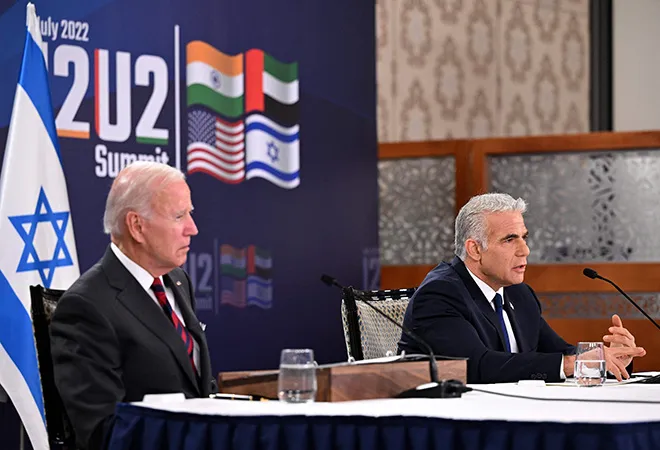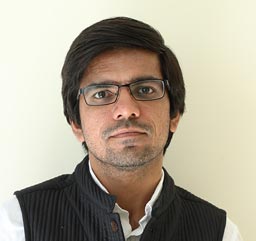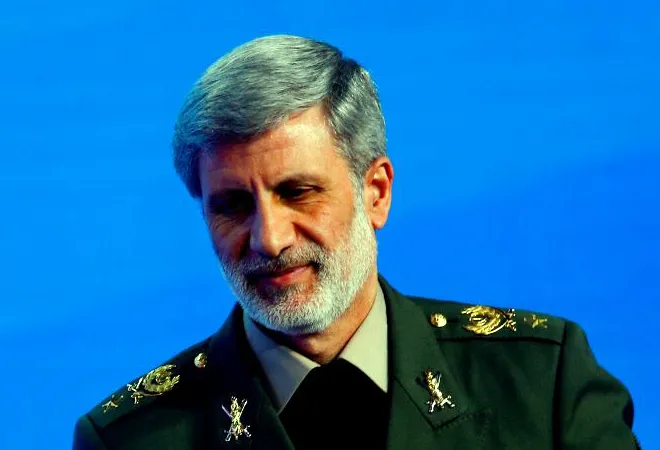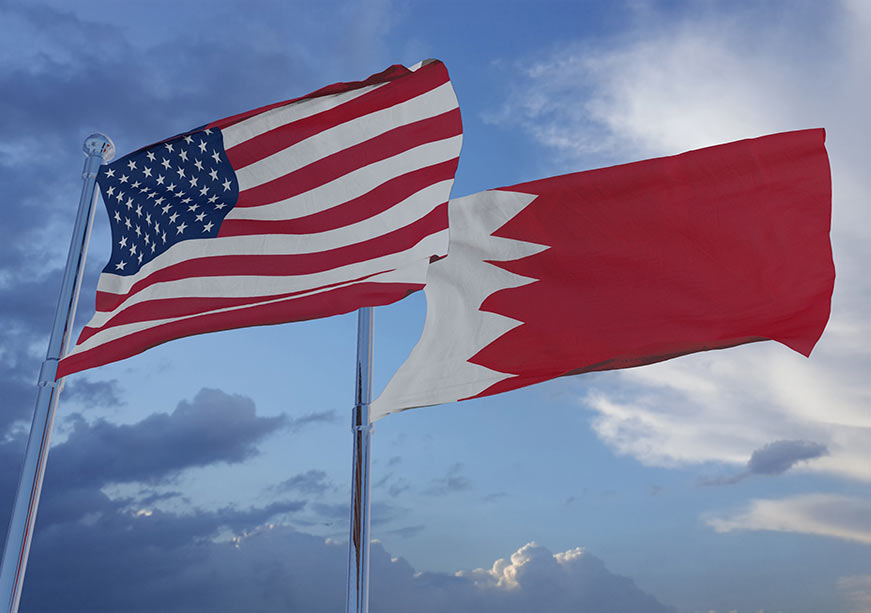The I2U2 grouping could be a game-changer in the region as it provides a platform for all the member states to outline new areas of cooperation.
The I2U2 group of countries, ‘I2’ standing for India and Israel and ‘U2’ representing the United States (US) and United Arab Emirates (UAE), held their first summit level virtual meet on 14 July, during US President Joe Biden’s visit to Israel. The summit-level talks come as a welcome push since the meeting of I2U2 foreign ministers in October 2021 was followed by a lull despite many analysts christening this new setup as the ‘Middle East Quad’ (or ‘West Asia Quad’).
All four member countries have highlighted six main areas of cooperation that have been selected to launch this engagement into its next stage. With geoeconomics being the central tenant, cooperative projects in the fields of water, food security, health, transportation, and space cooperation have been identified as the first set of pilots, operating under larger global umbrellas of issues such as international economic stability, climate change, volatile energy, and food markets that have disproportionately affected the Global South, compared to the more developed parts of the world. The Quad is the correct format to take fast decisions, Israel’s Prime Minister Yair Lapid said, perhaps indirectly questioning the feasibility of larger groups such as the United Nations (UN) or the G20 to deliver quickly and concretely in a more complicated world.
The geoeconomics of it all
Undoubtedly, the scene-setter for the I2U2 was the signing of the Abraham Accords in 2020, which brought Israel and a group of Arab Gulf states led by the UAE into official partnership and recognition. The aim of the grouping is clearly to build more efficient cooperation in spheres where both regions can aid each other’s economic security. Israel today has the opportunity of using the financial prowess of centres such as Dubai to market its technology-driven offerings, something which the country is known for. And the first benefactors of the same have been the Gulf states themselves, with defence technologies offered by Israel quickly finding interest in the region with states such as Bahrain reportedly looking at Israeli drones and anti-drone systems to counter the threat from Iran. However, Israel, the UAE to a certain extent, and some other Gulf states rely heavily on imports to supply themselves with their daily requirements.
The aim of the grouping is clearly to build more efficient cooperation in spheres where both regions can aid each other’s economic security.
Recent disturbances to international supply chains caused by the COVID-19 pandemic, Russia’s war against Ukraine and more targeted plans to diversify global manufacturing capacities away from China have given significantly more weight to ‘minilaterals’ such as I2U2. One of the outcomes of the summit, that of the UAE investing US$ 2 billion to develop hi-tech integrated food parks across India, will not only bring a big technological boost to Indian agriculture through a potential UAE-Israel state and private sector cooperation, but also give critical food security capacity to Israel, the UAE, and their regional partners, offering a level of insulation from larger and more complicated international commodities trade frameworks. In return, India should also look for a greater say via the UAE and (indirectly) the US, with Abu Dhabi now often seen as the most influential Arab capital, in cartel-like ecosystems such as OPEC and OPEC+. Food security for the Gulf by design would go hand-in-hand with energy security for India.
Strategic opportunities amongst challenges
While the prospects of the I2U2 remain strong for the future, New Delhi will also appreciate the fact that strategically, India is the odd one out when it comes to the regional geopolitics of the Middle East. The first I2U2 summit has taken place during what many see as a very volatile visit of Biden to the region. Many Gulf players today are seeking a new strategic architecture with the US that would offer binding protection if any military conflict with Iran was to ensue. Biden, on the other hand, is having to maintain a balance between remaining a vital player in the region, but also not getting military entangled. The recent, messy American withdrawal from Afghanistan has only heightened anxieties in the Gulf of what American support without agreed guarantees would entail in the future. And to hedge their bets and diversify strategic plays, they are also willing to give space to the likes of Russia and China in the Middle East, much to Washington’s dismay.
For India, it leverages its good relations with Israel, the Gulf, and the US alike to build economic exchanges that are mutually beneficial with next to no downsides on the horizon.
While Lapid in his comments at the summit eluded to the ‘Quad’ as a good format, the US made direct comparisons to the original Quad in the Indo-Pacific, where the US, India, Japan, and Australia partner in a grouping that is effectively designed to curtail China’s influence in Asia. US National Security Adviser Jake Sullivan’s direct conflation between the original Quad and the development of the I2U2 as a ‘West Asian Quad’ may not position well two very diverse and strategically different areas for New Delhi. India being caught in a US-sponsored and backed Israel-Arab security deal would complicate the country’s known and appreciated ‘strategic autonomy’ in the Middle East as a state that chooses not to take sides. While an overall expired concept, non-alignment still resonates when it comes to India’s West Asia policy. The Abraham Accords, since their signing, have undoubtedly stabilised the region to a certain extent, but have also created two major blocks, one being Iran, and the other that is now seen as anti-Iran. This is despite side-line diplomacy, such as Saudi’s independent talks with Iran hosted by Baghdad, the UAE’s continuous cooperation with Tehran on certain issues and so on remaining constant. These concerns are not visible only from New Delhi’s vantage point but have also been raised in Europe, with scholars advising European capitals to not follow Washington’s lead by supporting a Gulf-Israeli defence pact and continue to work towards a regional de-escalation.
Conclusion
The I2U2, both on paper and in practice, makes a lot of sense. For India, it leverages its good relations with Israel, the Gulf, and the US alike to build economic exchanges that are mutually beneficial with next to no downsides on the horizon. However, geoeconomics and economic linkages cannot be seen as separate from geopolitics, and Middle East’s geopolitics remains volatile despite the Abraham Accords, with the Iran crisis looking to get even more complicated with chances of a JCPOA 2.0 remaining bleak. While none of these should dissuade India from aggressively developing economic linkages with a now ‘normalised’ Arab–Israel region, concern lingers that the Abraham Accords themselves are doing far too much heavy geopolitical lifting far too briskly, something that New Delhi, as the odd-one-out, should remain on top of.











